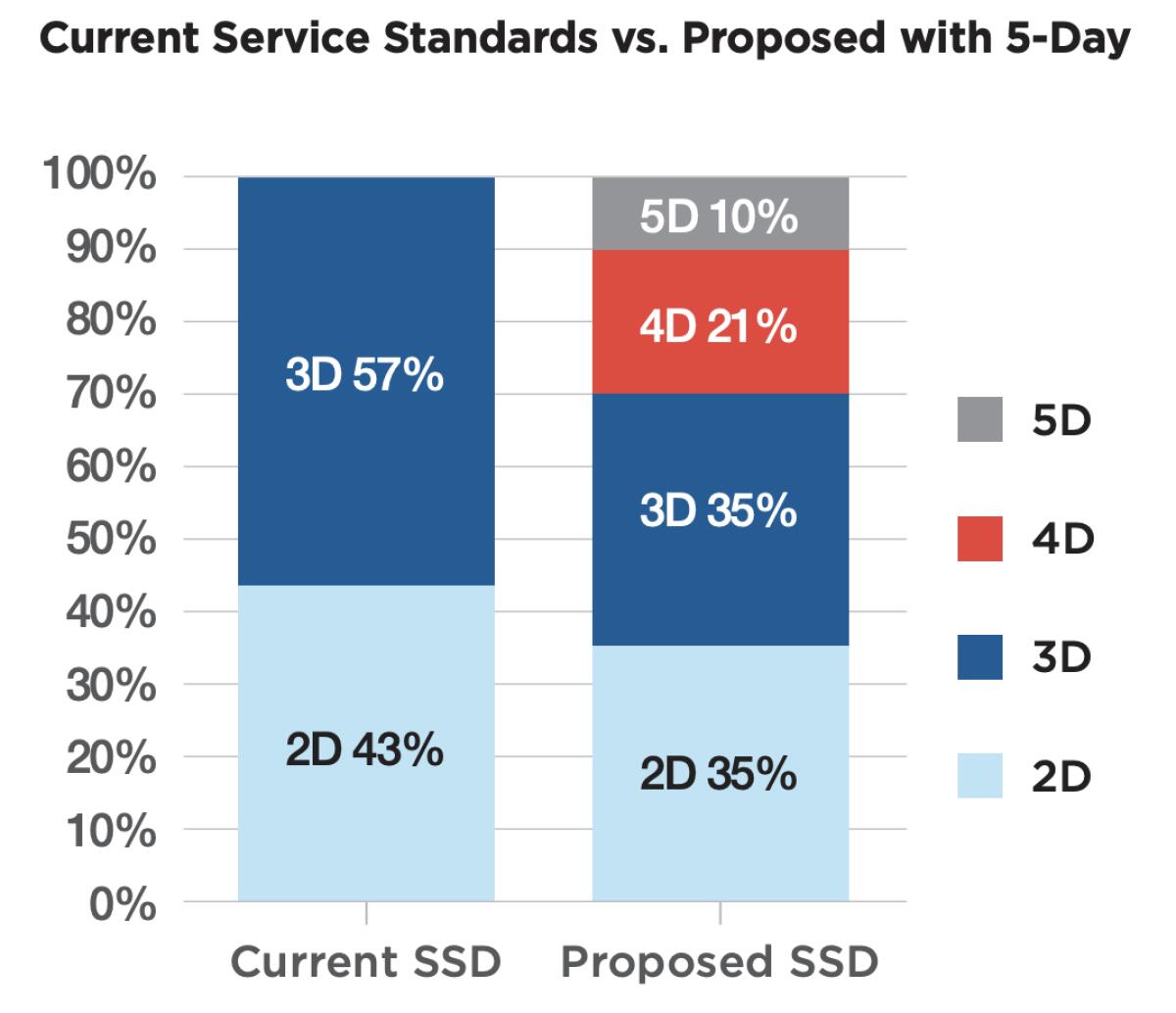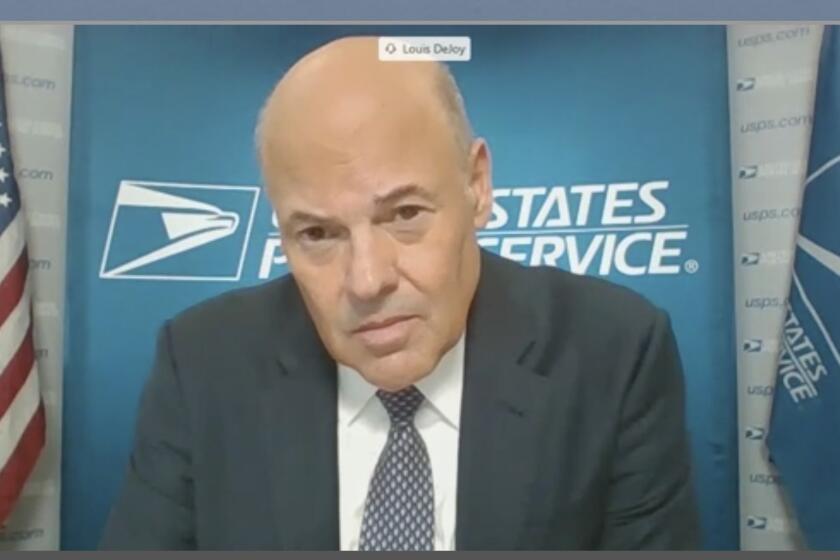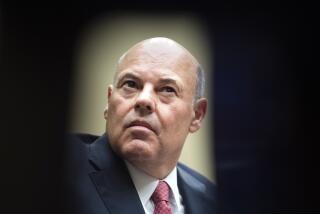Column: Stop saying the USPS should be ‘run like a business.’ It’s not a business

- Share via
The 10-year master plan for the U.S. Postal Service unveiled Tuesday by Postmaster General Louis DeJoy looks as though it will achieve his objective of placing the service on a sound business footing for a decade.
The plan would do everything that comes naturally to a hard-nosed business executive. That’s the bad news. The plan would stretch out mail delivery deadlines, raise postal rates (perhaps steeply), cut back on post office hours and close branches.
The worse news is inherent in these changes, taken all together. It’s that they reflect the notion that the USPS should be “run like a business,” to repeat the usual formulation.
Does it make a difference if it’s an extra day to get a letter?
— Postmaster General Louis DeJoy
This is a classic category error, in that it defines one object in utterly inappropriate terms. The Postal Service is not a business. Even those who say it should be run more efficiently, with smaller deficits or a profit, don’t really believe it’s a “business.”
The USPS is a public service — the truth is right there in its very name. Forcing it to operate like a business, say by paying its own way on a profit-and-loss basis, is a path to exacerbating its problems and destroying it from within.
Get the latest from Michael Hiltzik
Commentary on economics and more from a Pulitzer Prize winner.
You may occasionally receive promotional content from the Los Angeles Times.
Evidence of how the USPS differs from a conventional business is easy to find. The Postal Service has a statutory monopoly over letter mail. In return for what long has been assumed to be a competitive gift, it also has a statutory obligation to deliver mail to all points within the United States, at the same rates for a letter whether it’s going across town or from Key West to Hilo, Hawaii.
The ability of the USPS to set its own prices isn’t unlimited, in the sense that a private business can set its own prices; postal rates are subject to the oversight of the Postal Regulatory Commission (formerly the Postal Rate Commission), an independent body, which can weigh in on rates, though not veto changes.
The service is also subject to the oversight of Congress, which is bound to make its voice heard whenever the USPS airs plans to close local post offices, all of which are located in one or another member’s or delegate’s district.
It’s also subject to the mandate that it prefund its retiree healthcare liability. DeJoy’s plan calls for repealing the mandate, which is one of its good points. As he told the House Oversight Committee during a Feb. 24 hearing, in private enterprise and throughout the government, “for the most part,” such a mandate “is nonexistent.”
Louis DeJoy hasn’t been fired yet as postmaster general. Why the delay?
The USPS must meet its mandates while remaining financially self-sufficient, and while its core business of delivering first-class letter mail nationwide at a fixed price is shrinking inexorably. In that light, it may well be the case that DeJoy isn’t the worst conceivable leader for the service.
He’s obviously willing to make the maintenance of service standards secondary to eliminating the service’s financial deficit, which he projects to be $160 billion over 10 years. And he’s defended that position, albeit with unnecessary truculence, in numerous appearances on Capitol Hill.
DeJoy’s 10-year plan, upliftingly titled “Delivering for America,” brims with business jargon that most consumers probably recognize as excuses for service cutbacks. It talks of a “bold approach,” “optimized,” “modernized,” “structured for success” and new “pricing strategies.” (When have the latter ever meant lower prices?)
But DeJoy, a former logistics executive, is plainly not inclined to raise the basic question of why the USPS should break even, much less turn a profit. That makes him the wrong man for the job of postmaster general. He can’t be removed except through a vote of the USPS board of governors, which installed him last year after a curiously lackadaisical executive search.

President Biden has nominated three new members of the board to fill vacant seats. That would give the board a Democratic majority capable of ejecting DeJoy from his job. But it’s not 100% certain that it would do so.
The notion that the U.S. mails should operate self-sufficiently wasn’t heard much until the 1960s. It became law with the Postal Reorganization Act, signed by President Nixon in 1970.
To some extent the act was a response to a crushing eight-day mail strike that began in New York and spread nationwide. To win support for an act that eliminated the Postal Service as a Cabinet agency and placed it on its own financial footing, the postal unions got raises for their members and the statutory right to strike. (The 1970 walkout was technically illegal.)
Underlying the transformation, however, was the conviction that private enterprise always operates more efficiently than a government department. That’s the heart of the idea that the USPS should be run like a business.
Among the fundamental flaws in that idea is that there’s no evidence that private businesses consistently run better than government departments, especially given their divergent purposes. Private businesses go bankrupt all the time; nor are they immune from spectacular blunders.
One need only to look at California’s utility sector for sterling examples. Pacific Gas & Electric, the largest utility in the country, has been found negligent to the point of criminality twice in the last five years, once by a jury in 2016 in connection with the San Bruno gas line explosion, which killed eight, and more recently by its own guilty pleas to 84 counts of involuntary manslaughter for the 2018 Camp fire in Northern California.
Then there’s Southern California Edison, which bollixed an $800-million refurbishment of its San Onofre nuclear power plant so badly it turned the entire plant into a useless pile of concrete and metal sitting on the Pacific shoreline, awaiting final dismantling.
DeJoy’s name came out of nowhere in the search for a postmaster general
On the other hand, government’s role is to assume tasks that the private business won’t take on, typically because they won’t turn an immediate profit. That includes building public works such as Hoover Dam and the interstate highways and funding primary education. No one expects K-12 schools, or indeed public universities, to turn a profit. Americans travel much of our extensive interstate highway system for free — or at least free of out-of-pocket charges.
It’s true that private enterprise has stepped in to provide some of these services, but in almost every case they’ve created the antithesis of universal service.
Private primary schools charge fees that make them largely havens for the elite. As states have withdrawn their financial support of public universities, those have increasingly resembled private institutions, narrowing access for working-class families and burdening more students with debt.
Universal mail delivery is a quintessential public good, more so as its core responsibility becomes less profitable.
A postal service operating as a business would act as DeJoy recommends: It would relax standards for its most onerous tasks, such as delivering mail to distant and remote points, cut costs by reducing hours at retail outlets and shutting down those that are especially underused. And it would say it’s doing all these things to benefit customers.
DeJoy’s master plan comes right out of the private enterprise playbook. He acknowledges that the service hasn’t met its standard for delivery of first-class mail (reaching most parts of the U.S. within three days) for eight years.
DeJoy’s answer is to redefine the standard. Rather than meet the existing standard that first-class mail should reach its domestic destinations within three days, he would revise the deadline to five days; more than half of first-class mail would be subject to the new standard. The change resembles what airlines have sometimes done when their delays get out of line — they rewrite their schedules so that delays become on-time landings.
Google is bringing a fiber-optic data network to homeowners in Kansas City, Mo., and Kan., but without the usual regulations. That means underprivileged neighborhoods may be left in the digital dust.
As private businesses sometimes do, DeJoy minimized the impact of these and other changes on his customer base: “Does it make a difference if it’s an extra day to get a letter?” he asked at a House Oversight Committee hearing on Feb. 24. Maybe not for him, but it’s easy to imagine a day or two making a big difference for a postal customer waiting for a check.
All the talk one hears about the course of the USPS’s business being “unsustainable” derives from the notion that it could somehow go out of business if it can’t get its financial house in order. In isolation, DeJoy’s projection of $160 billion in red ink over 10 years sounds dire for an organization with average annual projected revenue of about $70.5 billion in that period.
In terms of the federal budget, however, it’s minimal — less than one-third of a percent of the projected government expenditures in the same time frame.
DeJoy’s recommended changes would turn that deficit into a profit reaching $1.2 billion in 2030, even with sizable capital investments in equipment.
One can accept his figures at face value, but they leave unanswered too many basic questions? Why must the USPS turn a profit? Why should its duty to deliver mail everywhere at a standard affordable rate be sacrificed to that goal?
If Congress is going to object every time a postmaster general recommends closing post offices, canceling Saturday mail deliveries, or reducing customer service in any of the other ways typically proposed to make the USPS more “efficient,” why shouldn’t it simply take over the funding of the service and run it in the public interest?
Those questions aren’t asked in the master plan. But they should be.
More to Read
Get the latest from Michael Hiltzik
Commentary on economics and more from a Pulitzer Prize winner.
You may occasionally receive promotional content from the Los Angeles Times.












